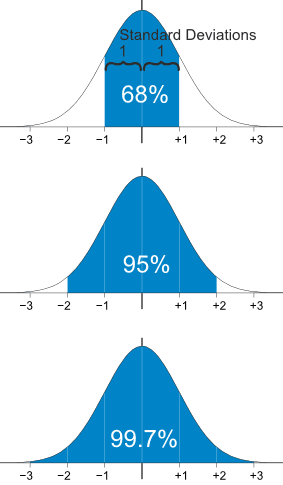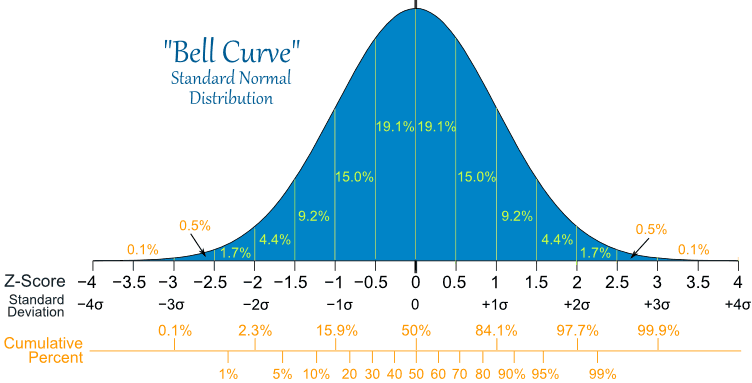I've never seen this topic discussed in collecting forums, or even mentioned online. This could have made for a nice paper (or eZine article), but I figured it'd make for a good Friday post.
So, for those not familiar with statistics, a Normal Distribution (Bell Curve) is used to explain many naturally occurring phenomenon. It is symmetric around the mean. For example, height, intelligence, income, etc. all tend to follow a Bell Curve. And in collecting, condition is no different.
This is the standard Bell Curve, as I would relate it to collecting:

Instead of arguing the exact descriptors here, just realize that "average" condition needs to center at the middle of the curve. In this case I've called it "Very Good". And each condition description represents an increase of 1 standard deviation from the mean. In other words, Good and Near Mint represent a +/- 1 standard deviation from the mean (Very Good). Acceptable to Mint would be +/- 2 standard deviations from the mean, and Poor to Gem Mint is +/- 3 Std Devs.
Now there is a lot of research out there on Bell Curve statistics, but the following is a great link if you'd like to educate yourself:
https://www.mathsisfun.com/data/s...
This is an important picture from that link:

Translating this into our collectibles, you'd expect about 68% of video games to be within Good to Near Mint, 95% between Acceptable and Mint, and 99.7% between Poor and Gem Mint. And you'd have outliers in the 0.3% leftover, perhaps cash fresh gem mint sealed games or cut rental boxes with sundamage.
So far, I've just related the bell curve to our hobby, nothing new here. Now for the next step. Why are Mint games so damn expensive compared to Poor? Well, it is easy enough to explain with a bit of math.
Let's call the price of a Poor game to be the "Cost of Ownership". If you can get a poor conditioned, label damaged Little Samson cart for $400, then it costs at least $400 to own a Little Samson cart (that is legit, of course). For example purposes, let's say price increases by $100 at each condition step... so $500 for Acceptable, $600 Good, $700 VG up to $1000 for Gem Mint (as a cart).
Now this picture becomes important:

Let's start at -3 Standard Deviations, i.e. "Poor". We’ll count the bucket around -3, from -2.5 to -3.5. This produces a value of 0.6% (0.5%+0.1%), meaning 0.6% of collectors willing to pay the cost of ownership for the worst conditioned item. Now there'd be a lot of guys who would pick up a Poor conditioned item on the cheap (to sell / trade / use as placeholder), but very few would pay the going market rate for it.
Now at the Acceptable level, we count the bucket from -1.5 (4.4%) to -2.5 (1.7%). Thus 6.1% of collectors would buy an Acceptable game at the Acceptable price. Repeat the same process and you get 24.2% in Good range, 38.3% in Very Good, 24.2% in Near Mint, 6.1% in Mint and 0.6% in Gem Mint. Once again, basically mimicking the Bell Curve.
However, what about people who would buy an Acceptable condition game at a Poor price, i.e. the cost of ownership? All of the Poor collectors would buy it (better condition at same price) and the Acceptable guys would as well (better price at same condition). Note that the inverse is not true though, as no one would pay the Acceptable price for a poor conditioned item.
So in reality, we’d have the 0.6% of Poor collectors + 6.1% of Acceptable collectors = 6.7% of collectors in the market for an Acceptable condition item at the Poor price. Of course resellers would have interest as well, but let’s ignore that argument for now.
And this behavior would repeat up the chart. Everyone would pay the Poor price for a Gem Mint condition.
Without using too much math, our previous charts of the Bell Curve are actually the probably density function (pdf) of the Normal Distribution. The behavior we are now describing is the cumulative distribution function (cdf) of the Normal Distribution. The same data, just this one is presented cumulatively.

Note the extremely high demand at the best conditioned items, when price is just at the cost of ownership level. What does this mean?
There are very few collectors at both ends of the spectrum, but for different reasons. There are few poor collectors because most collectors naturally care about condition. People may want better condition, but realize they’ll have to pay more for it. On the Gem Mint side, there are few collectors simply because many people are priced out. People will accept a lower condition to save themselves some money.
So this has an important impact on pricing. If a Poor item gets cheaper, it still does not meet the Acceptable collector’s condition requirements. So they’ll probably drag their feet on the purchase, letting it depreciate some more. At some point, if the price gets too cheap, then they may eventually buy it as a placeholder and look to upgrade down the road. But there is no limit on how far that price can fall.
As for the Gem Mint item, let’s say it begins to depreciate. It will meet the condition requirement for every single collector in the market, so there is natural demand… just many cannot afford it. It has a definite floor at the Mint level of pricing, because the Mint collectors would buy Gem Mint at a Mint price. It also has one huge factor that a Poor item does not have… upgrade appeal. When Gem Mint appears, any current owners at lower condition levels may want to purchase the upgrade and sell off their old copy.
One last point. You must remember that any collectible hobby can be hot (seller’s market) or cold (buyer’s market) at any given time. Prices have been up in this hobby for a while, but prices can also fall.
In terms of our Bell Curve, the items in the middle of the curve will typically follow the overall trend of the hobby. If it is hot they will appreciate, if it is cold they may stagnate or fall.
Items at the top end of the curve (Gem Mint) may have a chance to at least remain flat, or even appreciate, in a down trending hobby. Simply because the demand for them is far greater than anything else in the hobby. The condition appeals to everyone, just not the price of the item. So thus if the price begins to fall even slightly, someone may consider that a buying opportunity.
And last, you have the items at the bottom of the curve. They typically only appeal to new collectors who have to have the item, but cannot find a better one (because it is rare), or cannot afford a better one (because it is expensive). And when a hobby does go through a downtrend, this typically coincides with a lack of new demand. These become the items that stagnate or decrease in price without any bottom in sight. Although, on a positive note, speculative resellers do actually create a floor here (typically 50% of value). They are willing to take the gamble and hope that the hobby enters back into an uptrend at some point.
If you made it this far, thanks for reading! Would love to hear any feedback or comments. I tried to keep the math simple, but there’s a lot more concepts from calculus and probability / statistics that would apply here.









